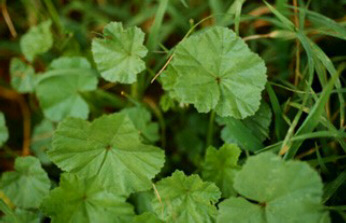

Mallow
Malva neglecta
Blooms all year in some areas,
from April to October in most.
Annual to biennial. Alien.
This omnipresent weed resembles the geranium in leaf and often in habit. The dark green roundish leaves are 3/4" to 3" in diameter with 5-7 slightly round-toothed lobes on long petioles. Stems are variably prostrate to erect and branch from the base; glabrous, becoming hairy toward the tips. They can reach 3 feet in height, but normally grow to about a foot high.
One to several 1/4" pink, white, or lavender flowers bloom per axil, each with 5 petals. The fruit is segmented and looks like tiny green wheels, hence the common name "cheeseweed." Ten to 20 segments make up each fruit, with one seed per segment. Fruit is surrounded by a green, papery winged margin. The taproot is long with many rootlets. This plant grows anywhere with adequate sun and moisture. And it transplants well.
You will find a clue to mallow's uses in the etymology of its name. The word "mallow" is derived from the Greek maluke, meaning, "to soften," and is descriptive of the effects the herb has on the skin, mucous membranes, and digestive system.
This is a good plant to know if you are outdoors and away from your kitchen medicines. It can be picked and the leaves bruised on the spot for an instant poultice for wounds, skin irritations, sores, and inflammations. Back at home, a decoction of the fresh leaves can be applied to these areas. A fresh leaf poultice or decocted leaves can also be used for sore breasts and other neo-natal skin irritations. For boils or swellings, steep the leaves and use them as a poultice.
Internally, an infusion of the demulcent and expectorant leaves and flowers
will soothe coughs, emphysema, bronchitis, and tonsillitis. The infusion
can be used as a gargle for sore throats. And infusions of the leaves of
roots relieve indigestion, stomachache, and catarrhal gastro-enteritis.
The same infusion is diuretic, relieving urethral inflammation.
------------------------------------
Photo courtesy of Virginia Tech Weed Indentification
Guide http://www.ppws.vt.edu/weedindex.htm
<--index